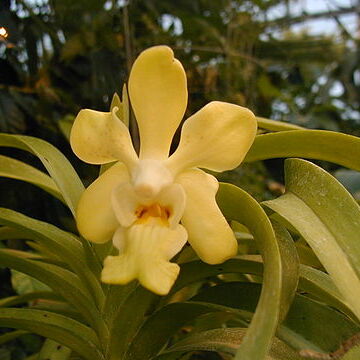Herbs, epiphytic, monopodial. Stems ascending or rarely arching, usually rather long, stout, rigid, with short internodes and many distichous leaves, with thick roots in lower part. Leaves distichous, flat, narrow, often closely spaced, linear to lorate, conduplicate toward base, with amplexicaul-sheathing base, jointed. Inflorescences erect or suberect, racemose, axillary, usually ascending, sparsely few to many flowered. Flowers large or medium-sized, usually colorful and long-lasting. Sepals and petals similar or sepals wider, often narrowed toward base, margins ± twisted or wavy, often tessellated; lip attached to an indistinct column foot, immobile, shortly spurred, 3-lobed; lateral lobes erect, small; mid-lobe large, usually with longitudinal keels or swellings adaxially. Column short, stout; rostellum short; anther cap subglobose; pollinia 2, subglobose, waxy, each strongly cleft or porate, attached by a common short stipe to a large viscidium.
More
Large epiphytic or lithophytic orchids with thick, fibrous, sparsely branched stems and long, thick, cord-like roots. Leaves either flattened and strap-like or cylindrical and fleshy. Racemes short, few-flowered. Flowers resupinate, moderately large, opening widely, on long pedicels. Sepals and petals similar in size and shape, stiff or fleshy, narrowed suddenly to basal stalk, often with wavy margins. Labellum immovably fixed by base of spur to base of column or apex of column foot. Labellum lamina 3-lobed; lateral lobes spreading; midlobe projecting like landing platform; spur parallel with ovary. Column thick, without basal foot or with very short foot. Pollinia 2, orange, hard, waxy, sessile, attached via short, broad stipe to large viscidium.

